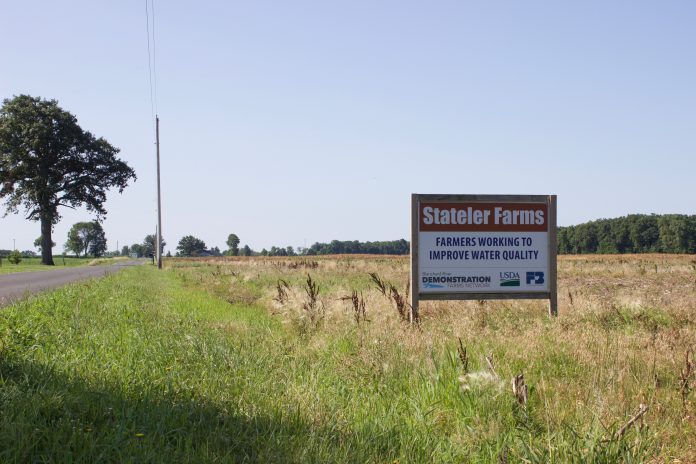
MCCOMB, Ohio — Anthony Stateler of Stateler Family Farms believes his farm and most of the farms around him are doing the right thing when it comes to handling manure. As part of the Blanchard River Demonstration Farms Network, he wants to confirm that belief, and take ownership of any mistakes they are making.
“We’ve had kind of gotten a black eye with what’s been happening with Lake Erie,” Stateler said about livestock and grain farmers in the area.
Phosphorus runoff from farms in the Western Lake Erie Basin has contributed to harmful algal blooms in Lake Erie, according to researchers.
“When they [The Ohio Farm Bureau] came to us about three and a half years ago, we knew that the lake had problems, and we always kind of opened our doors to our farm for people to come and see what we were doing,” Stateler said.
As part of the network, the Statelers, who raise 7,000 hogs and also farm grains, have continued to open their doors for tours.
“Part of our problem in agriculture is it seems like everyone is getting three or four generations removed from the farm,” Stateler said.
He believes many people who have not experienced farm life do not fully understand what farmers do. Nor do they know how technical farmers can be when it comes to dealing with manure and nutrients. By opening up the farm to tours, Stateler wants to can help people understand what farmers do and why.
In addition to tours, the Statelers have hosted multiple water quality improvement projects for the farm bureau and the National Resources Conservation Service.
“We’ve been able to say yay or nay to any projects so far, but we haven’t said nay yet,” Stateler said.
The project
This July, the Statelers have been hosting the KDS/Quick Wash Integrated Solution Project, a pilot program studying manure treatment techniques for reducing phosphorus in liquid manure that could give farmers more options for land application and make it easier to haul manure solids containing phosphorus away from the farm.
The farm produces approximately 2.5 million gallons of manure to deal with every year. It uses about 70% of the manure to fertilize its own fields and sells the remaining 30% for neighbors’ fields.
Stateler’s fields are not high in legacy phosphorus. He recognizes, however, the benefit for many fellow farmers in Mercer and Auglaize counties, where the livestock population is denser and legacy phosphorus is higher.
Technologies
Researchers looked into using centrifuges for the manure separator project, but the cost, $1.4 million, was prohibitive. They went with two other, more affordable technologies instead, according to Theresa Dirksen, Mercer County agriculture solutions coordinator.
The first is the KDS Separator, a machine that uses rotating plates to separate manure solids from liquids.
The machine can use a chemical polymer to increase separation, or operate without polymers.
With a polymer, the machine has successfully removed up to 87% of phosphorus from swine manure liquids into the solids.
The liquids from the KDS Separator can be land applied or further treated with the Quick Wash.
The Quick Wash introduces lime to remove phosphorus from manure solids. The process allows calcium phosphate to settle from the liquid.
On the farm
At Stateler Family Farms, the KDS Separator is set at the bottom of the driveway, in front of the barns and under a tent. It is larger than a composter, but not by much. In front of the machine is a plastic bin to catch the solids coming out.
The Quick Wash technology is set up in a trailer right next to the KDS Separator.
The outcome of the project at the Statelers’ farm will help determine the usefulness and feasibility of these technologies for hog farmers. The project is also being tested on dairy farms to see if it is a viable solution for treating cattle manure.
After treatment
The process will leave a liquid that needs to be land applied, and the nutrient content remaining in that liquid will determine how it can be applied.
“Typically phosphorus is the most limiting nutrient,” Dirksen explained.
If the phosphorus in the liquid is reduced, the liquid manure can be applied based on nitrogen or potassium, which can increase land application rates or reduce the necessary land base to apply.
The manure solids, containing the majority of the phosphorus, can be transported away from the farm.
The cost
A KDS Separator can cost $50-60,000. After the capital costs, the operating costs are relatively low.
“It all comes down to economics,” Dirksen said.
Their goal is to reduce operating costs to less than 1 cent per gallon of manure treated. The greatest operating cost is the chemical polymer, so one goal of the project is to determine the most cost-effective polymer.
Dirksen hopes agencies like the NCRS can help cover the capital costs for farmers through equipment funding, so farmers only need to worry about the operating costs.
In addition, companies want to buy the leftover calcium phosphate as a composting aid or fertilizer, which could generate some extra income for farmers.
Report incoming
Dirksen is analyzing samples while the project is in progress. The project will be at Statelers’ farm until Aug. 2 and will move to a dairy farm through the third week of August.
Once it is complete, Dirksen will compile a report with details on the operating costs and effectiveness of these technologies. That report is expected by the end of October.
Tour
The Blanchard River Demonstration Farms will have a summer tour Aug. 16 from 9 a.m. to 3:15 p.m.
The free event will allow people to see the conservation practices being implemented on the three farms, including Stateler Family Farms.









